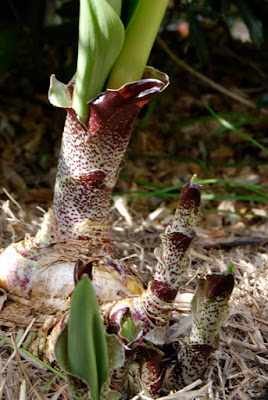No, I know what you're thinking, not the mewling and puking kind. I mean baby plants!
But it has taken a whole nine months of gestation from planting seeds in a pot to having babies make their appearance. In fact it has taken so long that I had even forgotten about them entirely, until this morning, when I spotted the lush, green shoots of my baby Scadoxus coming up. What a surprise, a thrill and a delight rolled into one little pot of green growth. Time for some photos and a few explanations.
 |
| Scadoxus babies, in rude green health. |
We've had our Scadoxus puniceus bulbs here since 2009. They were a gift from gardening writer Geoffrey Burnie, with whom I worked very happily for a number of years at Burke's Backyard magazine. Geoffrey gave me excellent instructions on choosing a spot and caring for them, and every year they flower in spring. The clump of them has been slowly but steadily increasing in size, and the number of flowering stalks has gone from the original three to about 10 this year (I say "about" as not all stalks flower, the younger ones seem to like having a practice run in the years leading up to their first flowering).
 |
| At the end of flowering they form large clusters of seed which start out green (like this) then eventually turn red ... |
 |
| ... like this. Nowhere near as many ripe seeds as unripe ones. |
My online reading about Scadoxus tells me they are both tricky and slow to propagate, and that's been my experience.
Talk about tricky! It's never worked until this year. And talk about slow! I planted the seed in a pot on December 19 last year, and I discovered the seedlings this morning, in the middle of August.
In previous years I sowed the seed around the base of the scadoxus clump, kept the soil lightly moist and well mulched ... and nothing ever happened.
Last December, I decided to try a pot. The seed were not buried deeply but they were fully covered with potting mix, and the pot was placed next to my potted goldfish pond in a spot which was warm and sheltered enough, but gets almost no direct sun at all. The scadoxus pot received regular but not very plentiful watering, living off the scraps of water which fell down onto it as I routinely splashed water around topping up the water in the goldfish pond and watering the nearby orchids.
That's hardly any kind of scientific "how to raise scadoxus from seed" report, but that's how it happened, and it seems to have worked ... so far.
Now I am faced with the responsibilities of parenthood. How to raise the babies ... so many decisions ... where to put them, what to feed them, when to transplant them into the ground. So here's the plan.
 |
| How many babies in that pot, one or five? I'll find out later. |
 |
| But won't it be worth the wait! |
This year, however, it's the cute little babies which are stealing the show by getting in early. It might have taken almost nine months to happen, but it definitely has been one of the highlights of my gardening year. Such simple fun!




Hi Jammie,
ReplyDeletespectacular flowers, lets hope the youngsters persevere!
Love to Pam as well...
Therese
What a wonderful post, these plants look very similar to what we call here blood lilies with rounder, ball like formation of the blooms. My guru told me their real name is haematis multiflorus! I have a few plants but only 1/ 2 bloom rest just send up leave each year.
ReplyDeleteGod this comment has become about me again. what i set out to write was that I enjoyed reading it and looking at the wonderful pictures including the beautiful one by Pam.
Looking forward to more
Thanks for your comments, Therese. I hope the youngsters persevere as well! And I hope you and Peter are enjoying life. Hope to see you soon.
ReplyDeleteAnd Shivangni, Haematis is actually Haemanthus, which is the older botanical name of the same genus, now called Scadoxus. The flowers of your Haemanthus (Scadoxus) multiflorus are red, while mine (Scadoxus puniceus) are orange, but they are both from the same genus, and both are great looking flowers!
I've never seen these but they look fantastic. Mind you I don't think I have the patience to wait years and years for the hope of some flowers, even if they are beautiful!
ReplyDelete